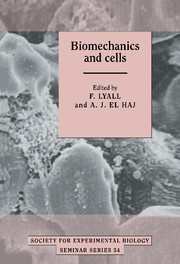Book contents
- Frontmatter
- Contents
- List of contributors
- PART 1 SOFT TISSUE
- PART 2 HARD TISSUE
- Cellular modelling of mechanical interactions with the skeleton
- Mechanical and hormonal influences in vivo cause regional differences in bone remodelling
- Mechanically sensitive cells in bone
- Mechanical stress and bone development
- Application of homogenous, defined strains to cell cultures
- Role of arachidonate in load transduction in bone cells
- Effects of mechanical stretch on actin polymerisation in fibroblasts of the periodontium
- Modulation of cartilage extracellular matrix turnover by pulsed electromagnetic fields (PEMF)
- Index
Mechanical stress and bone development
Published online by Cambridge University Press: 19 January 2010
- Frontmatter
- Contents
- List of contributors
- PART 1 SOFT TISSUE
- PART 2 HARD TISSUE
- Cellular modelling of mechanical interactions with the skeleton
- Mechanical and hormonal influences in vivo cause regional differences in bone remodelling
- Mechanically sensitive cells in bone
- Mechanical stress and bone development
- Application of homogenous, defined strains to cell cultures
- Role of arachidonate in load transduction in bone cells
- Effects of mechanical stretch on actin polymerisation in fibroblasts of the periodontium
- Modulation of cartilage extracellular matrix turnover by pulsed electromagnetic fields (PEMF)
- Index
Summary
Introduction
It has been well established that the skeleton, just like the muscular apparatus, responds to changes in applied mechanical stress by changing its mass. This phenomenon was first described by Wolff some hundred years ago in his book Das Gesetz der Transformation der Knochen (Wolff, 1986). Wolff was struck by gross changes in trabecular organisation of bones as a result of dramatic changes of their mechanical environment, as for instance occurs after maladjustment of the bone ends after a fracture. Wolff's Law, which is in fact not a law but the description of a biological phenomenon, states that bones adapt their tissue density and architecture to the functional demands of their mechanical environment, to obtain maximal strength with minimal tissue mass. Increased stress leads to denser bone, as in the dominant arm of professional tennis players (Montoye, Smith & Fardon, 1980), while stress reduction, as for instance after long-term bed rest, reduces bone density (Whedon & Heaney, 1993).
While these phenomena are quite apparent at the anatomical and tissue level, it is not well known how they are achieved at the cellular and molecular level. How skeletal cells react to mechanical stress in terms of cell proliferation and matrix metabolism, and what intermediate molecules are involved, are still matters of debate. Even the nature of the final physical stimulus which acts on the cell to modulate its behaviour has not been unequivocally determined.
- Type
- Chapter
- Information
- Biomechanics and Cells , pp. 187 - 196Publisher: Cambridge University PressPrint publication year: 1994



